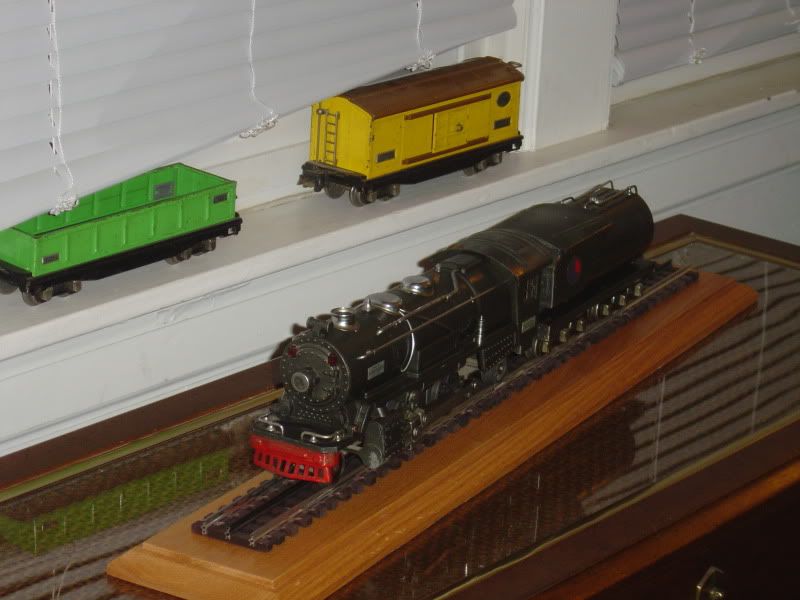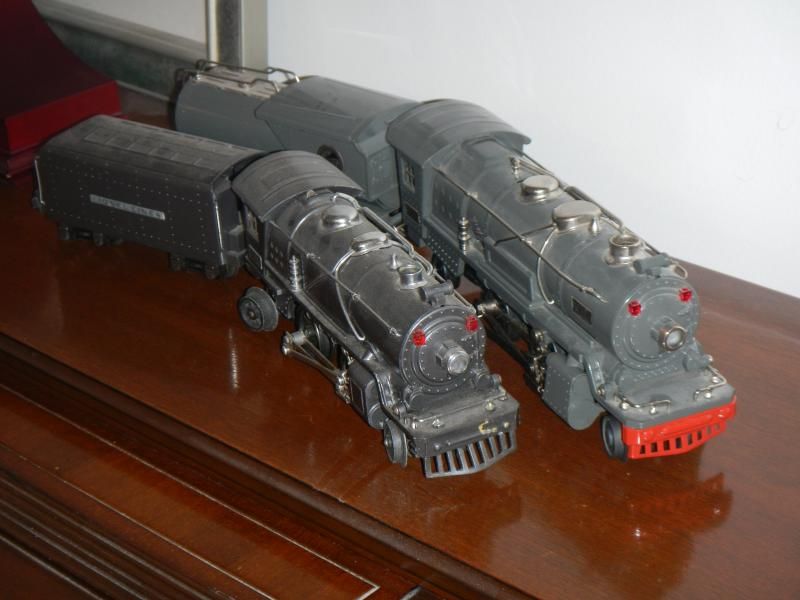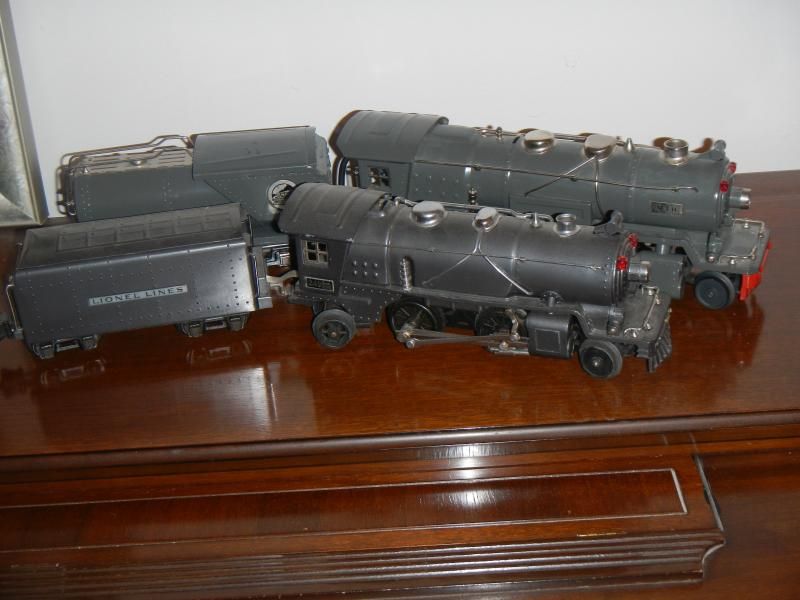What's the difference?
Replies sorted oldest to newest
At least two different sizes. Lionel for a number of years made O gauge trains of three or four different sizes - in every catalog.
Which would be the correct sized locomotive to pull 2800 series boxcars?
263E came in quite a few freight sets with 2800 series cars.
Steve
Joe Lyons,
Steve is correct about the 263E train sets the 800 series rolling stock were the 1st cars that came on the original 263E, which included the big 810 Crane Car, later these Cars became the 2800 series rolling stock. The 260E came with both 800 and later 2800 rolling stock also. I would need to review the 261E & 262E Train Set to see exactly which rolling stock, 1st came with those trains sets, not sure of the sizes of the 261E & 262E engines and tenders off the top of my head. I do believe the 262E is the smaller engine & tender, in the 259E size range. I do own the original Lionel 259E & 264 train sets, both originally came with 2600 series rolling stock, however the 264 is the mid size Lionel Tin Plate, engine & tender, between the 263E and the 259E Train sets.
PCRR/Dave
The Original Lionel 263E Engine & 12 Wheel Tender
The Repro MTH 263E P2 on the right & Original Lionel 264 on the left, note the difference in sizes, 2nd picture is the MTH P2 263 pulling a mix of 2800 & 800 rolling stock.
Attachments
The 260 & 263 were similar size but the 263 has marker lights and the 260 has flags. The piping detail is a little different, too. The 260 had a taller tender but MTH has sometimes paired the engine with the 263 tender. The 261 and 262 are very similar but smaller than the 260 & 263. Both have flags and not marker lights. These appear with various tenders. Understanding the subtleties and reasons for the variations in the original Lionel issues would take a lot of research.
Thanks a lot for all that info!
The 260 & 263 were similar size but the 263 has marker lights and the 260 has flags. The piping detail is a little different, too. The 260 had a taller tender but MTH has sometimes paired the engine with the 263 tender. The 261 and 262 are very similar but smaller than the 260 & 263. Both have flags and not marker lights. These appear with various tenders. Understanding the subtleties and reasons for the variations in the original Lionel issues would take a lot of research.
rdg is right.
The variations and differences are very extensive and require a lot of research and study/observations of both real locomotives and the Lionel catalogs. It would take several pages to detail them all for you here.
Actually the last versions of the 261 and 262 (satin black/nickel trim) sometimes came with the marker light boiler front (from a 249E locomotive).
These are often found in sears and other DSS / uncataloged sets.
The 261/262 is also larger/longer than the 258 and 259 and has a diecast metal frame.
The 261/262 is basically a little brother to the 260/263,
a 2nd cousin to the 257,
and a red headed stepchild to the 259
The 264 is streamlined (Com. Vanderbilt) and only shares motor parts.
All of these locomotives began their lives in as early as 1930 and were being phased out for more realistic looking diecast boiler models in about 1937-38.
The 260 & 263 were similar size but the 263 has marker lights and the 260 has flags. The piping detail is a little different, too. The 260 had a taller tender but MTH has sometimes paired the engine with the 263 tender. The 261 and 262 are very similar but smaller than the 260 & 263. Both have flags and not marker lights. These appear with various tenders. Understanding the subtleties and reasons for the variations in the original Lionel issues would take a lot of research.
A related question: can someone tell me why the original tender with my Lionel 262 is so much narrower than the loco? Is it just one of those Lionel quirks? Or were some prototype tenders actually narrower for better rearward visibility for switching etc?
Attachments
Joe,
Remember also that the different rolling stock for these original Lionel Tin Plate trains all come with several different kinds of couplers, so the purchaser must know which couplers are on his particular train, when purchasing additional rolling stock for his train set. The smaller 2600 series has a transition Box Car with pre war Auto coupler on one end, and post war/modern coupler on the other, for pulling all different kinds of later made Lionel rolling stock, simply Lionel's way of blending everything together.
PCRR/Dave
Ace,
Lionel used that particular tender behind different size engines, it also came with my 259E, which is the smaller of the Tin Plate engines, it pulled the 2600 series rolling stock. So I am not quite sure what Lionel's real intention was in designing that particular tender, it could have been for running with the different size engines.
PCRR/Dave
Ace,
Lionel used that particular tender behind different size engines, it also came with my 259E, which is the smaller of the Tin Plate engines, it pulled the 2600 series rolling stock. So I am not quite sure what Lionel's real intention was in designing that particular tender, it could have been for running with the different size engines.
PCRR/Dave
You are most likely correct; I imagine Lionel just carried the tender over from a previous smaller loco. Thanks Dave.
Ace,
Lionel used that particular tender behind different size engines, it also came with my 259E, which is the smaller of the Tin Plate engines, it pulled the 2600 series rolling stock. So I am not quite sure what Lionel's real intention was in designing that particular tender, it could have been for running with the different size engines.
PCRR/Dave
You are most likely correct; I imagine Lionel just carried the tender over from a previous smaller loco. Thanks Dave.
Joe,
Remember also that the different rolling stock for these original Lionel Tin Plate trains all come with several different kinds of couplers, so the purchaser must know which couplers are on his particular train, when purchasing additional rolling stock for his train set. The smaller 2600 series has a transition Box Car with pre war Auto coupler on one end, and post war/modern coupler on the other, for pulling all different kinds of later made Lionel rolling stock, simply Lionel's way of blending everything together.
PCRR/Dave
Ives 1122,
There are 2 different Tin Plate 264's the 264 I am speaking of is the mid size version of the original 263E engine pictured below, it actually has a different 4 wheel tender also. Not the Com V passenger train engine & tender, you identified in your post. Most people make this mistake, there are not many of the original 264 mid sized work trains, even in pictures. I finally picked one up from one of our OGR members. I also own the original 259E, which is smaller in size than the 264 and has the slide shoot tender that appears behind Ace's 262E engine. Next Christmas season, I will line them up and take a picture so you can see the 3 different size Lionel Steamer Tin Plate Engine's, each with it's own different Tender.
PCRR/Dave
The 3rd Picture is the original Lionel 264 on the left, the MTH Repro P2 263E on the right. I just sent the original Lionel 264 out to Gunrunnerjohn to see if he could install the TMCC/ERR in her, if so it will be the only Pre War 264 TMCC/ERR Steamer in existence.
The original 263E in Gun Metal Gray.
The inner oval pictures the 259E work Train, with the original slide type Tender and 2600 consist.
PCR/Dave,
Somewhere along the line of ownership the number plates were changed. The loco you have there with the 263E is a 249E. This loco used the same frame and boiler as the 261E and the 262E. Engine length is 9¾".
Ron M
I'm not sure I follow that ... my loco (originally my father's) is a 262 (not a 262E, if it makes a difference) with a sheet metal tender, and I believe it is from 1931-32. It was probably outfit #181 based on the accompanying cars.
Attachments
I'm not sure I follow that ... my loco (originally my father's) is a 262 (not a 262E, if it makes a difference) with a sheet metal tender, and I believe it is from 1931-32. It was probably outfit #181 based on the accompanying cars.
Ace, your loco should have a diecast metal tender shell on sheet metal frame. From your pics it looks correct for your loco.
The tinplate tender Ron referred to is smaller in size.
A 262 is manual reverse (lever in cab)
A 262E has the Ives style 4 position reverse unit that Lionel adopted after purchasing Ives (Named E-unit by Lionel).
Ives 1122,
There are 2 different Tin Plate 264's the 264 I am speaking of is the mid size version of the original 263E engine pictured below, it actually has a different 4 wheel tender also. Not the Com V passenger train engine & tender, you identified in your post. Most people make this mistake, there are not many of the original 264 mid sized work trains, even in pictures. I finally picked one up from one of our OGR members. I also own the original 259E, which is smaller in size than the 264 and has the slide shoot tender that appears behind Ace's 262E engine. Next Christmas season, I will line them up and take a picture so you can see the 3 different size Lionel Steamer Tin Plate Engine's, each with it's own different Tender.
PCRR/Dave
The 3rd Picture is the original Lionel 264 on the left, the MTH Repro P2 263E on the right. I just sent the original Lionel 264 out to Gunrunnerjohn to see if he could install the TMCC/ERR in her, if so it will be the only Pre War 264 TMCC/ERR Steamer in existence.
The original 263E in Gun Metal Gray.
The inner oval pictures the 259E work Train, with the original slide type Tender and 2600 consist.
Dave, you should start collecting (and reading) Lionel catalogs. They are quite affordable right now. Reproduction catalogs are also plentiful in the 2nd hand market, typically less expensive, and provide the same quality education.
ron m,
I have seen 3 other 264 engines & their original Lionel train set boxes, down thru the years here in the Pittsburgh, Pa area. None of the tags were ever switched, everyone has the Ives ident on the tags also. Now the Lionel company may have put the wrong tags on these train sets long ago, however they must have mismarked the original boxes also.
As I said before most people have never seen these particular train sets, and they are an unlisted item for Lionel. I have only seen 4 of these train sets, in my life time. All were exactly alike. It's one of the reasons I purchased this particular 264 engine and Tender. I am really hoping Guns can put the TMCC/ERR controls in her, she will really be something special then.
Ives 1122,
The problem with the catalogues and books is they are all incomplete, they only give a partial view of all Lionel's full product lines, and people start to believe they are actually fully complete information. There is some pretty cool stuff in them however!
PCRR/Dave
ron m,
I have seen 3 other 264 engines & their original Lionel train set boxes, down thru the years here in the Pittsburgh, Pa area. None of the tags were ever switched, everyone has the Ives ident on the tags also. Now the Lionel company may have put the wrong tags on these train sets long ago, however they must have mismarked the original boxes also.
As I said before most people have never seen these particular train sets, and they are an unlisted item for Lionel. I have only seen 4 of these train sets, in my life time. All were exactly alike. It's one of the reasons I purchased this particular 264 engine and Tender. I am really hoping Guns can put the TMCC/ERR controls in her, she will really be something special then.
Ives 1122,
The problem with the catalogues and books is they are all incomplete, they only give a partial view of all Lionel's full product lines, and people start to believe they are actually fully complete information. There is some pretty cool stuff in them however!
PCRR/Dave
ron m,
I will take a closer picture so you can read the idents yourself, when she comes back from Guns works shop.
PCRR/Dave
ron m,
I will take a closer picture so you can read the idents yourself, when she comes back from Guns works shop.
PCRR/Dave
ron m,
None of the tags were ever switched, everyone has the Ives ident on the tags also. however!
PCRR/Dave
Dave, what "Ives ident" are you referring to?
Ives1122,
On the Original Lionel 264 engine Cab ident, it also says Ives at the end, if I remember correctly, the engine is up with Guns right now having the TMCC/ERR installed
in her, so I can not see the ident right now.
PCRR/Dave
Unfortunately this is the closest picture I have of her right now, depending on your computers ability, you maybe able to enlarge the picture, to see the 264 ident tag on the side of the cab.
PCRR/Dave,
You need a new pair of glasses, the number board reads 249E L/ionel/ines.
Ron M
Have to agree with Ron that I also see "249 Lionel Lines" on the plate when zooming in....which makes sense, as your picture shows a 249 Locomotive.
I don't see "Ives" anywhere on the plate.
Studying the Lionel O gauge family of steam locomotives is a fine art that takes a well rounded education, and a skillful eye for noticing minute details.....both internally (motor) and externally (body& trim).
Here is a streamlined 265, almost identical to a 264, but with more deluxe drive rods.

Ives1122,
To PCRR/Dave "ines" reads "ives". That's why I said he needs a new pair of glasses.
Ron M
ron m,
I stand corrected Guns looked at my original Lionel engine and it is a 249, no E and an L appears for Lionel, after the 249, my mistake. Maybe I am just getting old! This means the other train sets I saw as a teenager, had to be 249's also.
PCRR/Dave
ron m,
I stand corrected Guns looked at my original Lionel engine and it is a 249, no E and an L appears for Lionel, after the 249, my mistake. Maybe I am just getting old! This means the other train sets I saw as a teenager, had to be 249's also.
PCRR/Dave
ron m & PCRR/Dave,
I learned a valuable lesson from this thread, THANK YOU!! ![]()
Happy Pappy,
Me to, never talk about the numbers on an engine when it's not available to actually see, I am not 25 years old any more.
PCRR/Dave












